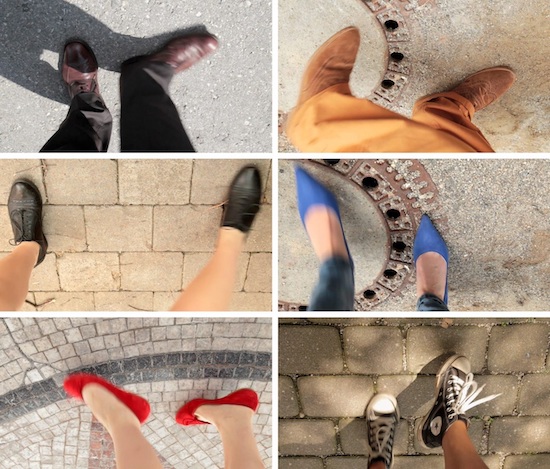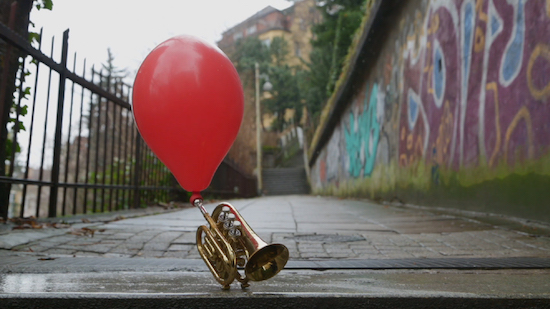Nevin Aladağ, Traces, 2015, video still. © the artist. Courtesy the artist and Wentrup, Berlin
Black boots shimmy on an iron grate. Loafers jump and jive on cobblestones. A pair of trainers skip playfully to and fro in a shallow puddle over tarmac. Sandals slip and slide on a bed of loose gravel.
In Nevin Aladağ’s three-minute single-channel video work Top View (2012) it is not so much a question of the dancer becoming the dance. We hear the rhythm of the steps, but more than that: we hear, too, the tone colour of the street itself, the distinctive timbres of different urban surfaces.
It is the disintegration of any distinction between an instrument, its player, and the site of performance. This successive tumble of feet, captured from ankle on down by the camera’s frame in the ‘top view’ of the work’s title, may be dancing the city – but the city is dancing them too.
Born in the eastern Turkish city of Van, Aladağ moved to Germany whilst still a child and spent the 1990s studying at Munich’s Akademie der Bildenden Künste and now lives in Berlin. In 2002, she participated in Weisbaden’s forty-year celebration of the original Fluxus festival. It’s easy to see why. Her work has a similar mischief to it, not to mention it’s distinctly Fluxian blurring of borders between music, art, and life.
Since then her work has been included in several major shows throughout mainland Europe, as well as in Asia, America, and the Republic of Ireland. But she remains less well-known in the UK, with – up until the present solo show at the Hayward – only a couple of works included in the A Foundation’s (2010) group show exploring Turkish migration and the Hayward Gallery’s own exhibition dedicated to dance and art, Move: Choreographing You, in the same year.
Dance has been a persistent focus of Aladağ’s work, with works like Occupation inviting flash mobs of dancers to take over gallery spaces and Raise the Roof presenting a kind of silent disco with various headphone-wearing women dancing to different songs that only they can hear on oblong podiums in a courtyard at the 2017 Venice Biennale. Such work seemingly riffs on sociologist Michael Bull’s work on ‘mobile listening’ and the acoustic bubbles formed around iPod users, but Aladağ adds another, more explicitly musical element by miking up the dancer’s platforms to produce aleatoric polyrhythmic compositions, close in many respects to concert works like Louis d’Heudieres’ Laughter Studies series.
‘Fanfare’, the present show at the Hayward features, alongside Top View looped on a monitor in the gallery’s lobby, a pair of wall-based sculptures and two further video works – both split across three screens – along similar themes of music, movement (in several senses), and urbanism. Traces (2015) offers up a concert in, of, by, and around Stuttgart featuring two triangles hung from a branch tinkling in the breeze, a violin strapped to a carousel that strikes a bow on every pass, an accordion which plays a chord as it unfurls from the top of a streetlamp, and a drum rumbling down a tarmac path, along with several other instruments on a kind of jury-rigged autopilot.

Nevin Aladağ, Top View, 2012, video stills. © the artist. Courtesy the artist and Wentrup, Berlin
The instruments themselves have been carefully chosen to reflect the city’s particular cultural mix. There’s elements of German folk (the accordion) and classical music (violin) plus a Turkish davul bounding down a flight of steps (over 23,000 Stuttgart residents are from Turkey). The work follows on from 2013’s Session (also on show here), which takes a similar musical tour of Sharjah and its surrounding area in the United Arab Emirates, with percussion instruments jingling and clattering as they tumble down desert dunes or roll through dockside dirt roads. But while the earlier work consists exclusively of the shake and rattle or percussion instruments, Traces feels more traditionally ‘musical’, featuring every orchestral family, from the aforementioned strings and drums to a bugle and a pipe both blown by helium balloons, drifting into the air as they whine or parp disconsolately.
The film clips, ranging from a few seconds to around a minute, have been combined in a way that feels distinctly ‘composed’. Intensities rise and fall, chords combine harmonically or face off in counterpoint, rhythms combine with tones and texture in a way that seems full, quasi-symphonic even. But there’s something about their aleatoric performances that feels oddly human. The tones tremble and fluctuate, sound at times nervous and uncertain, other times brash – even impassioned.
And yet one other way, Traces differs from its predecessor is precisely in the absence of humans in this film. In Session we catch, in back of shot, passers-by in djellabas, a couple strolling through the park, shopkeepers looking on baffled at the sight –presumably – of a woman steadying her camera on a small drum while she chucks little stones at its skin. But Aladağ’s Stuttgart is almost entirely depopulated, save a few blurry figures partially glimpsed here and there. We are constantly reminded of this absence of the human by children’s rocking horses that rock without a rider, flights of stairs without anyone to climb them, a playground with no players. Only the mannequins in the shop windows are left to act as Aladağ’s audience in this eerily post-apocalyptic cityscape, an unhome emptied of inhabitants, haunted by ghostly rattles and tones. This city doesn’t need us people anymore to play in its spectral symphony.
The Hayward’s wall-mounted bumf sells the picture as a “series of instruments ‘played’, not by musicians, but by the city of Stuttgart”. And clearly there are moments – in both films – where that is exactly what we are seeing: it is the spin of the carousel that plays the violin, the flow of the tide (in Session) that beats the drum. But there are other times when it is more like the instruments are playing the city. As a single drum tumbles down a metal stairway we hear the metallic resonance of the stairs as much as – or even more than – the duller thud of the drum itself Bells dragged along paving stones do themselves jingle but they also activate the pavement itself, scraping and scratching it into life, as an instrument in its own right. At these moments, as in Top View, the line between instrument and player becomes blurred. The city becomes an actor in a lively sonorous network.
Nevin Aladağ ‘Fanfare’ is at the Hayward Gallery until 13 April 2020,


